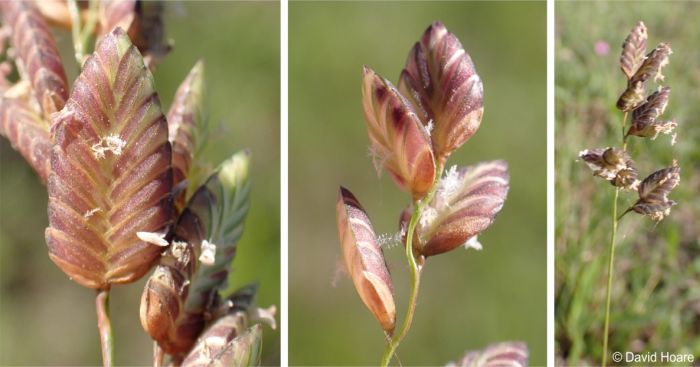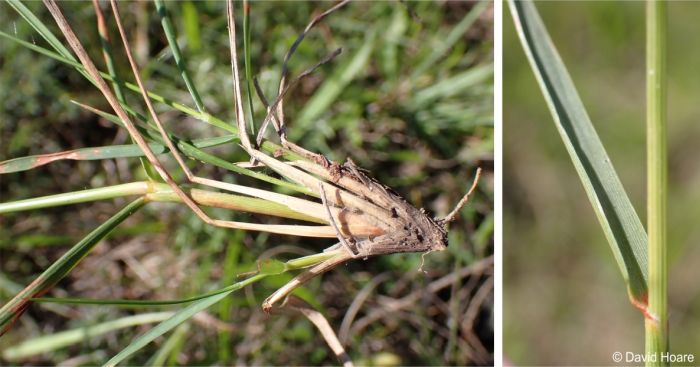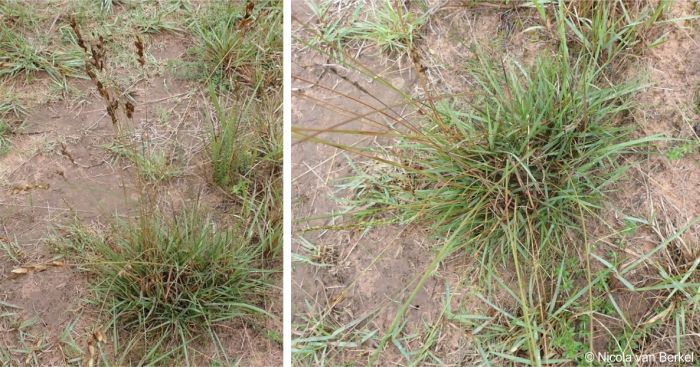Eragrostis capensis
Eragrostis capensis (Thunb.) Trin.
Family: Poaceae
Common names: Cape love grass, small heart-seed grass (Eng.), bosluisgras, hartjiegras, hartjie eragrostis (Afr.); baroa, baroana, la-barao, la-baroana, senana (Sesotho); umbimbane (isiZulu)
Introduction
Cape love grass can be recognized easily because of their heart-shaped and purple-flushed spikelets; the best guide to the identification of species of Eragrostis is to look at their spikelets.

Description
Description
Eragrostis capensis is a tufted perennial, growing up to 900 mm high, with short, horizontal rhizomes. Basal sheaths glabrous to hairy but not woolly-hairy; leaves mainly basal; culm without glands. Leaf blade is 70–350 × 2–5 mm, eglandular. Inflorescence is sparsely branched or unbranched, contracted or open and spreading; lowest branches not whorled; axils glabrous; spikelets adpressed; pedicels stiff, usually short. Spikelet is 3.5–15.0 × 3–7 mm, plump, opposite row of florets overlapping and closely packed; rachilla not visible, persistent, lemmas and/or paleas breaking up from base upwards; glumes subequal, apex acute to obtuse, back rounded, reaching ± 4/5 up lemma above, ovate in side-view; lemma 2.5–4.0 mm long, obtuse to subobtuse, back rounded, dull and granular, greenish to greenish-brown, strongly flushed purple, lateral nerves distinct; palea narrowly obovate, keels entire, wingless, membranous to subcartilaginous between the keel and margin, margins nearly touching to touching in lower parts to widely separated in upper parts, narrowing between keel and margin from base to apex, falling with or soon after lemma; anthers 3, 1–2 mm long; caryopsis elliptic, dorsally flattened. Eragrostis capensis flowers during summer, from spring (September) to autumn (April).
Similar to Eragrostis cimicina, which has a smooth, shiny lemma, and palea between keels and margins approximately the same width throughout. Sometimes confused with Eragrostis superba, with spikelets very strongly flattened, edges jagged, and entire spikelet disarticulating as a unit below glumes.

Conservation Status
Status
The current conservation status of Eragrostis capensis, according to the South African National Biodiversity (SANBI) Red list of South African plants, is Least Concern (LC). Cape love grass is one of the first grasses to sprout in the early spring and after veldfires. It is also palatable, but it has a low leaf production.
Distribution and habitat
Distribution description
Eragrostis capensis is mainly found in southern Africa, Central Africa, East Africa, as well as Madagascar and Thailand. In South Africa, Eragrostis capensis occurs in Limpopo, North West, Gauteng, Mpumalanga, Free State, KwaZulu-Natal, and the Northern, Western and Eastern Cape Provinces. It also found in Namibia, Botswana, Lesotho and Eswatini (formerly Swaziland). Cape love grass often grows grows on river banks, vlei areas where the soil is moist for the great part of the year and sometimes extending into woodland. It is often found beside tar roads where additional rainwater collects and also in disturbed places. In temperate South Africa is also found on drier soils in sour highveld grassland.

Derivation of name and historical aspects
History
The genus Eragrostis derived from the Greek words eros meaning ‘love’ and agrostis meaning ‘a kind of grass’. The species name capensis is Latin, meaning ‘of the Cape’. The genus Eragrostis has ±350 species which are cosmopolitan, mainly occurring in subtropical regions; ±90 species occur in southern Africa where they are widespread.
Ecology
Ecology
Eragrostis capensis is found in loam, sandy to clayey soils in moist areas on slopes, rocky and disturbed places. In southern Africa it is widely common, especially after veldfire. Cape love grass is pollinated by wind and is also the first grass to sprout after veldfire.
Uses
Use
It is well utilized by livestock and game until more palatable grasses become available. Only utilized in early spring as it has low leaf production. On the Highveld of South Africa it can be a reasonably palatable pioneer, but is not productive. In Lesotho it is burnt in various magical ceremonies. It can used as an ornamental grass, especially in the grassland garden.

Growing Eragrostis capensis
Grow
The optimal periods for propagating Eragrostis capensis is in early spring and autumn. These seasons offer ideal temperature and moisture conditions, enhancing root establishment and growth. Ensure adequate light (full sun) and well-drained soil to support healthy development.
Post-propagation, Eragrostis capensis requires consistent moisture until established. Ensure that the soil remains slightly moist but not waterlogged. Protect young plants from excessive direct sunlight and monitor actively for any pests or diseases. Regularly weed the surrounding area, as weed competition can hinder growth. Once established, Eragrostis capensis generally becomes more drought-tolerant and requires minimal maintenance. Apply a balanced fertilizer during the growing season to encourage robust growth. It is a beautiful grass to grow in the garden.
References
- Chippindall, L.K.A. & Crook, A.O. 1976. Grasses of southern Africa. Collins, Harare [Salisbury].
- Fish, L., Mashau, A.C., Moeaha, M.J. & Nembudani, M.T. 2015. Identification guide to southern African grasses. Strelitzia 36: 271–276. South African National Biodiversity Institute, Pretoria.
- Hoare, D. 2024. Observation of Eragrostis capensis, Wolwedans, Groot Brakrivier, South Africa. iNaturalist. Online. https://www.inaturalist.org/observations/215724238.
- Leistner, O.A. (ed.). 2000. Seed plants of southern Africa: families and genera. Strelitzia 10. National Botanical Institute, Pretoria.
- Van Berkel, N. 2024. Observation of Eragrostis capensis. Dune Molerat Trails, Garden Route District Municipality, South Africa. iNaturalist. Online. https://www.inaturalist.org/observations/213513490.
- Van Oudtshoorn, F. 1999. Guide to the grasses of southern Africa. Briza Publications, Pretoria.
Credits
Aluoneswi Caroline Mashau
National Herbarium, Pretoria (PRE)
September 2024
Acknowledgements: images by David Hoare and Nicola van Berkel from their observations uploaded on iNaturalist.
Plant Attributes:
Plant Type: Grass
SA Distribution: Eastern Cape, Free State, Gauteng, KwaZulu-Natal, Limpopo, Mpumalanga, North West, Northern Cape, Western Cape
Soil type: Sandy, Clay, Loam
Flowering season: Spring, Early Summer, Late Summer, Autumn
PH:
Flower colour: Brown, Purple
Aspect: Full Sun
Gardening skill: Easy
Special Features:
Horticultural zones











Rate this article
Article well written and informative
Rate this plant
Is this an interesting plant?
Login to add your Comment
Back to topNot registered yet? Click here to register.